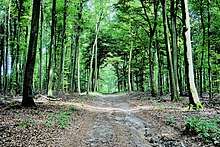Grünewald (Luxembourg)
The Grünewald (Luxembourgish: Gréngewald) is a forest in central Luxembourg, most of which is owned by the national government. Grünewald stretches through the communes of Niederanven, Steinsel, and Walferdange; the centre of the forest is situated 6 kilometres (3.7 mi) north-east of central Luxembourg City. As a result of its proximity to Luxembourg's capital city, it is a popular destination for tourism, leisure, and hospitality. Within the Grünewald are the sources of the Black Ernz and the White Ernz.

History
The Grünewald is held in great affection by the Luxembourgian people, dating as it goes back from the 1900 formation of the country in the 1840s.[1] In 1846, the government proposed selling the 6.69 square kilometres (1650 acres) remaining of the forest to raise money for economic development. The forest was bought by Baron Ziegesar for 530,000 Guilders, and presented to Grand Duke William II.[1] In grand ducal possession, the Grünewald's territory was expanded greatly by a series of acquisitions.[1]
In 1890, however, the end of the personal union between the Netherlands and Luxembourg meant the owner of the Grünewald was no longer the Luxembourgian sovereign, but Queen Wilhelmina of the Netherlands. The following year, Grand Duke Adolphe. bought the forest, by now 24.43 km² (6,037 acres) in size, from the Dutch crown for 2,788,798 francs.[1] Over the following 35 years, the territory was augmented further by a series of separate purchases; during the same period, some areas of the Grünewald was sold off.[1]
Due to financial hardship at the height of the Great Depression, in 1934, Grand Duchess Charlotte sold much of the Grünewald, together with Berg Castle, to the Luxembourgian government.[1] Of the total price tag for the two properties of 40 M francs, 20 M was denoted for the Grünewald; this was seen to have undervalued the forest (as it did the castle), as it had been assessed by the government as being worth 25 M francs.[1] The sale included 7.76 km² (1,920 acres) of the forest, leaving 10 km² (2,500 acres) in the hands of the Grand Duchess.[1] Urban legend has it that Charlotte's husband, Prince Félix, lost the Grünewald at a casino, but this is false; the revenue went to pay for the upkeep of the grand-ducal household, and was not spent on personal consumption, let alone gambling losses.[1]
Since 1934, the size of the Grünewald has fallen, mostly as a result of expansion of Luxembourg City and the construction of numerous roads in and around the area.[1]
Gallery
 Porte du Grünewald (Gate to Grünewald) in Luxembourg City
Porte du Grünewald (Gate to Grünewald) in Luxembourg City.jpg) A pond in the woods
A pond in the woods.jpg) Winter
Winter.jpg) Rocky outcrops
Rocky outcrops.jpg) Ruins
Ruins.jpg) An old pavillon
An old pavillon Catholic heritage site
Catholic heritage site Lieu-dit Rendez-vous
Lieu-dit Rendez-vous
Footnotes
- Juncker, Jean-Claude (15 February 2007). "Réponse à la question parlementaire no.1220 du 4 août 2006 de Messieurs les Députés Gast Gibéryen et Roby Mehlen" (PDF) (in French). Investigateur. Archived from the original (PDF) on 27 September 2007. Retrieved 2007-06-27.